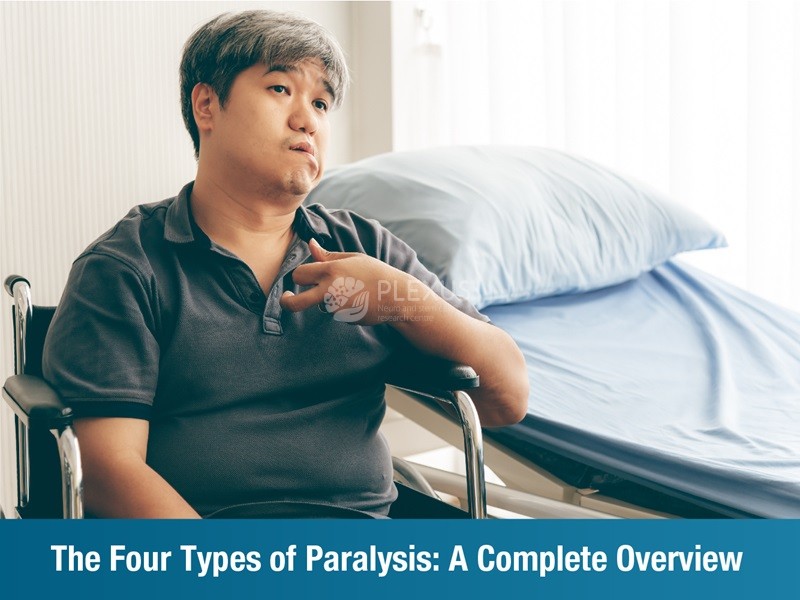
The common man’s understanding of paralysis is the “complete inability to move, to sense touch, or to control bodily sensations.”
While this may be true, it does not fully explain the extent of physical immovability a patient may experience. The real meaning of paralysis is significantly more nuanced because the extent to which a person is not able to move his/her body (as a whole or part) may undergo changes over a period of time. The recovery, whether complete or partial, depends on how active the patient is, their medical history, and various other factors.
In simple words, paralysis means inability to move the body. It could be either temporary or permanent. It happens as a result of nerve damage, and not because of injury to the affected part.
Types of paralysis
There are four types of paralysis that are classified according to the extent of immovability which is determined by the type of nerve that has sustained damage. These four types are:
Monoplegia
It is paralysis of a single area of the body, in most cases just one limb. People with monoplegia are generally able to retain control over the rest of their body, but cannot move or feel sensations in the affected limb. One of the most common causes of monoplegia is cerebral palsy. Other causes of this form of partial paralysis include:
- Stroke
- Tumors
- Nerve damage due to injury or disease
- Nerve impingement
- Motor neuron damage
- Brain injury
- Impacted or severed nerves at the affected location
Hemiplegia
This type of paralysis affects the arm and leg on the same side of the body. This too may be caused by cerebral palsy. The intensity of this condition varies from person to person and may change with time.
Typically, hemiplegia starts with a sensation of pins and needles and progresses to muscle weakness, and culminates in complete paralysis. Level of functioning of people affected with this condition varies day to day depending on the overall health, age, activity level and other factors.
Hemiplegia sometimes is temporary and getting the patient cured out of this condition depends on treatment, particularly early interventions such as physical therapy and occupational therapy.
Note: Hemiplegia is not the same as hemiparesis. In the case of the latter, the patient experiences weakness in one side of the body. Hemiparesis can be a warning sign of hemiplegia, especially for people with neurological disorders.
Paraplegia
This type of paralysis is defined by impaired movement below the waist. It usually affects both legs, hips and other functions such as having sex and elimination of waste from the body.
It is often misrepresented as a type of paralysis that leads to the inability to walk, move legs, or feel anything below the waist. However, paraplegia is very subjective, and can vary from person to person. While it results in significant impairment in mobility, paraplegia does not always culminate in permanent and complete paralysis.
There have been cases where people with paraplegia have made complete recovery spontaneously! These are wonderful reminders that paraplegia doesn’t mean the end of the world.
The most common cause of paraplegia is a spinal cord injury. These injuries hamper the brain’s ability to send and receive signals below the area of the injury. Other triggers include:
- Spinal cord infections
- Spinal cord lesions
- Brain tumors
- Brain infections
- Rarely, nerve damage at the hips or waist
- Brain or spinal cord oxygen deprivation due to choking, surgical accidents, violence, and similar causes
- Stroke
- Congenital malformations in the brain or spinal cord
Paraplegia vs Hemiplegia
While both these terms are often used interchangeably, it is important to understand the difference between paraplegia and hemiplegia. The former typically affects the lower half of the body, usually legs. The latter affects one side of the body, and can involve one side of the face, arm, or leg, or even a combination of these three.
Quadriplegia
This type of paralysis results in immovability below the neck. Also known as tetraplegia, it generally affects all four limbs as well as the torso. As with paraplegia, the level of disability and the loss of function differ from person to person. Some quadriplegic patients regain full or partial function spontaneously, while the rest gradually retrain their brains and bodies through specialised physical therapies and exercises.
At times, quadriplegia can be a temporary condition due to brain injuries, stroke, or temporary compression of spinal cord nerves.
The most common cause of quadriplegia is a spinal cord injury. Other causes of quadriplegia include:
- Acquired brain injuries due to infections or, stroke
- Spinal and brain lesions
- Spinal and brain tumors
- Spinal and brain infections
- Catastrophic nerve damage
- Congenital abnormalities
- Early brain injuries, especially pre-birth or during-birth
- Allergic reactions to drugs
- Drug or alcohol overdoses
Cell Therapy for paralysis
With cell therapy, conditions like paralysis can be effectively managed with many patients showing improvements in range of motion and mobility.
At Plexus we use autologous mesenchymal cells to manage spinal cord injuries which are the most common causes of paralysis.
Injected autologous mesenchymal cells form fresh synapses and axonal sproutings that facilitate the growth of new neurons. With time, the cells also transmit messages between the brain and spinal cord. Structural improvements in the cell tissues can restore blood supply and support mobility.
To know more about Cell therapy for paralysis at Plexus, reach out to us today.
WhatsApp +91 89048 42087
Call +91 78159 64668 (Hyderabad) | +91 82299 99888 (Bangalore)










